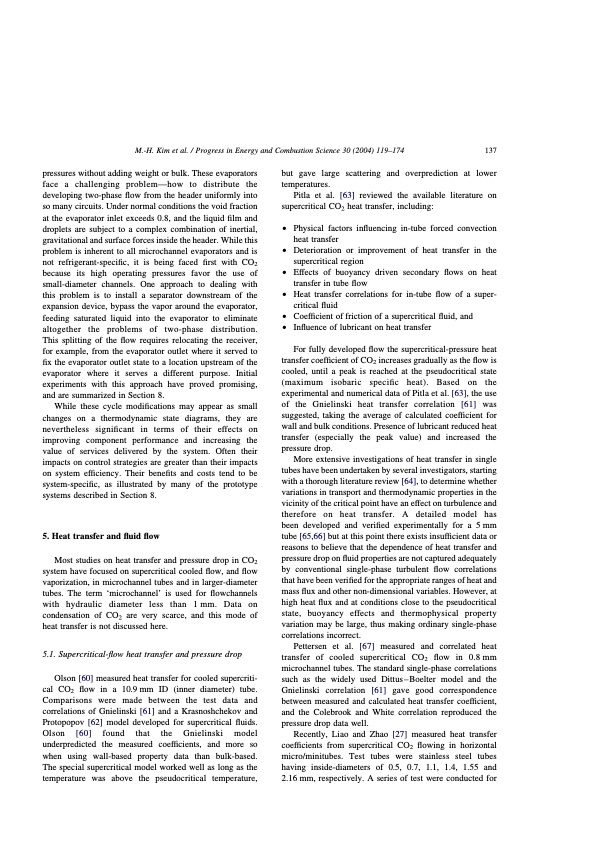
PDF Publication Title:
Text from PDF Page: 019
M.-H. Kim et al. / Progress in Energy and Combustion Science 30 (2004) 119–174 137 pressures without adding weight or bulk. These evaporators face a challenging problem—how to distribute the developing two-phase flow from the header uniformly into so many circuits. Under normal conditions the void fraction at the evaporator inlet exceeds 0.8, and the liquid film and droplets are subject to a complex combination of inertial, gravitational and surface forces inside the header. While this problem is inherent to all microchannel evaporators and is not refrigerant-specific, it is being faced first with CO2 because its high operating pressures favor the use of small-diameter channels. One approach to dealing with this problem is to install a separator downstream of the expansion device, bypass the vapor around the evaporator, feeding saturated liquid into the evaporator to eliminate altogether the problems of two-phase distribution. This splitting of the flow requires relocating the receiver, for example, from the evaporator outlet where it served to fix the evaporator outlet state to a location upstream of the evaporator where it serves a different purpose. Initial experiments with this approach have proved promising, and are summarized in Section 8. While these cycle modifications may appear as small changes on a thermodynamic state diagrams, they are nevertheless significant in terms of their effects on improving component performance and increasing the value of services delivered by the system. Often their impacts on control strategies are greater than their impacts on system efficiency. Their benefits and costs tend to be system-specific, as illustrated by many of the prototype systems described in Section 8. 5. Heat transfer and fluid flow Most studies on heat transfer and pressure drop in CO2 system have focused on supercritical cooled flow, and flow vaporization, in microchannel tubes and in larger-diameter tubes. The term ‘microchannel’ is used for flowchannels with hydraulic diameter less than 1mm. Data on condensation of CO2 are very scarce, and this mode of heat transfer is not discussed here. 5.1. Supercritical-flow heat transfer and pressure drop Olson [60] measured heat transfer for cooled supercriti- cal CO2 flow in a 10.9 mm ID (inner diameter) tube. Comparisons were made between the test data and correlations of Gnielinski [61] and a Krasnoshchekov and Protopopov [62] model developed for supercritical fluids. Olson [60] found that the Gnielinski model underpredicted the measured coefficients, and more so when using wall-based property data than bulk-based. The special supercritical model worked well as long as the temperature was above the pseudocritical temperature, but gave large scattering and overprediction at lower temperatures. Pitla et al. [63] reviewed the available literature on supercritical CO2 heat transfer, including: † Physical factors influencing in-tube forced convection heat transfer † Deterioration or improvement of heat transfer in the supercritical region † Effects of buoyancy driven secondary flows on heat transfer in tube flow † Heat transfer correlations for in-tube flow of a super- critical fluid † Coefficient of friction of a supercritical fluid, and † Influence of lubricant on heat transfer For fully developed flow the supercritical-pressure heat transfer coefficient of CO2 increases gradually as the flow is cooled, until a peak is reached at the pseudocritical state (maximum isobaric specific heat). Based on the experimental and numerical data of Pitla et al. [63], the use of the Gnielinski heat transfer correlation [61] was suggested, taking the average of calculated coefficient for wall and bulk conditions. Presence of lubricant reduced heat transfer (especially the peak value) and increased the pressure drop. More extensive investigations of heat transfer in single tubes have been undertaken by several investigators, starting with a thorough literature review [64], to determine whether variations in transport and thermodynamic properties in the vicinity of the critical point have an effect on turbulence and therefore on heat transfer. A detailed model has been developed and verified experimentally for a 5 mm tube [65,66] but at this point there exists insufficient data or reasons to believe that the dependence of heat transfer and pressure drop on fluid properties are not captured adequately by conventional single-phase turbulent flow correlations that have been verified for the appropriate ranges of heat and mass flux and other non-dimensional variables. However, at high heat flux and at conditions close to the pseudocritical state, buoyancy effects and thermophysical property variation may be large, thus making ordinary single-phase correlations incorrect. Pettersen et al. [67] measured and correlated heat transfer of cooled supercritical CO2 flow in 0.8mm microchannel tubes. The standard single-phase correlations such as the widely used Dittus – Boelter model and the Gnielinski correlation [61] gave good correspondence between measured and calculated heat transfer coefficient, and the Colebrook and White correlation reproduced the pressure drop data well. Recently, Liao and Zhao [27] measured heat transfer coefficients from supercritical CO2 flowing in horizontal micro/minitubes. Test tubes were stainless steel tubes having inside-diameters of 0.5, 0.7, 1.1, 1.4, 1.55 and 2.16 mm, respectively. A series of test were conducted forPDF Image | CO2 Vapor Compression Systems

PDF Search Title:
CO2 Vapor Compression SystemsOriginal File Name Searched:
co2-vapor-compression-systems.pdfDIY PDF Search: Google It | Yahoo | Bing
CO2 Organic Rankine Cycle Experimenter Platform The supercritical CO2 phase change system is both a heat pump and organic rankine cycle which can be used for those purposes and as a supercritical extractor for advanced subcritical and supercritical extraction technology. Uses include producing nanoparticles, precious metal CO2 extraction, lithium battery recycling, and other applications... More Info
Heat Pumps CO2 ORC Heat Pump System Platform More Info
| CONTACT TEL: 608-238-6001 Email: greg@infinityturbine.com | RSS | AMP |